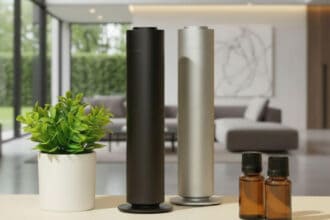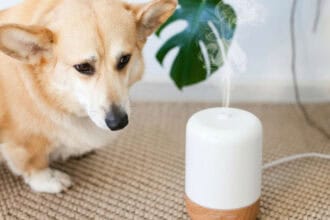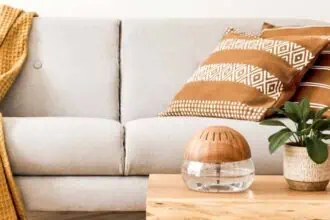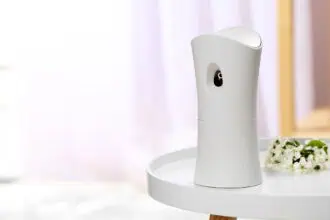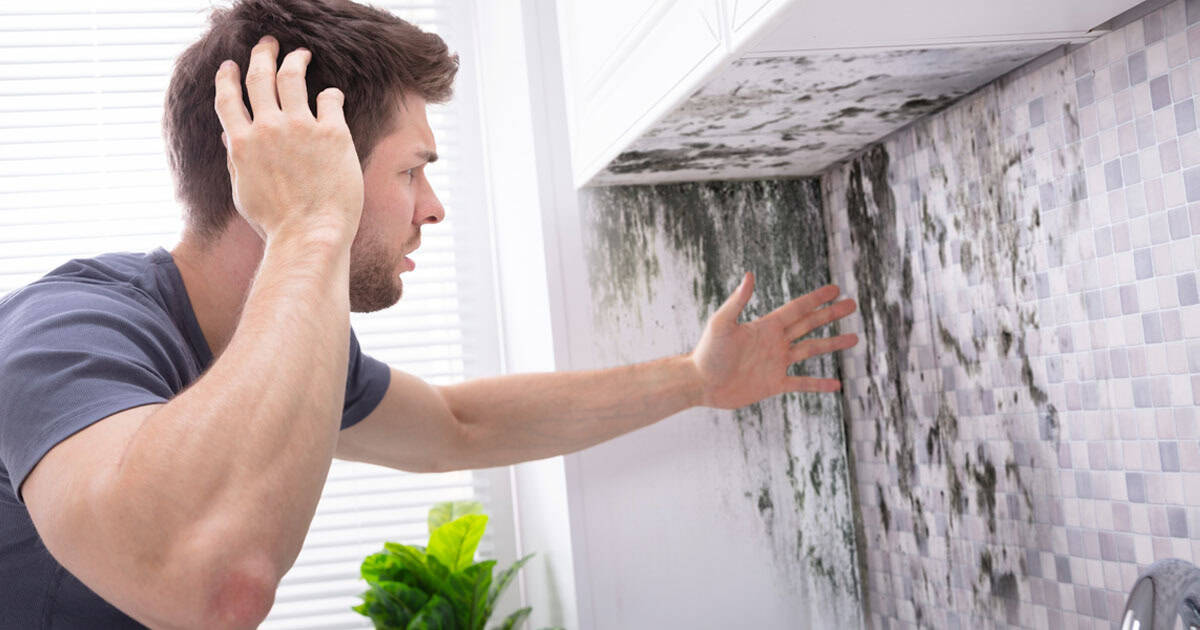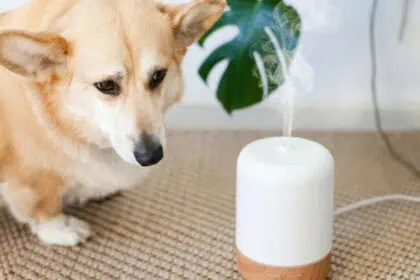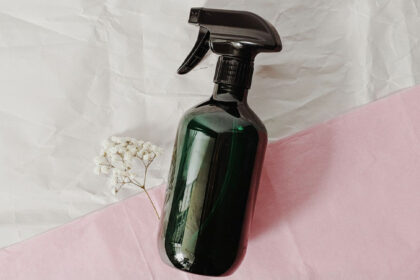Getting rid of mildew smells in your home can be tricky. This guide will help you on how to remove the mildew smell in your home. We’ll explain what causes these smells, how to find where they come from, and the best ways to eliminate them.
Why You Should Remove Mildew Smell?
Removing mildew smell is important because:
- Comfort: Mildew smell makes your home unpleasant. Getting rid of it will make your home smell fresh and cozy.
- Health: Mildew or mold can hurt your health, especially if you have breathing problems or allergies. Indoor mildew can make it harder to breathe and cause illness.
Learning to remove mildew smell will make your home healthier and nicer. After this, your home will smell fresh again.
Understanding Mildew Smell
A mildew smell in your home usually means mold is growing. Tiny fungi that grow in warm, damp places produce this smell. As mildew grows, it releases chemicals called VOCs, which cause the familiar unpleasant odor.
Common Places Where Mildew Smell Comes From in Homes:
- Basements: These areas are often cold and damp, making them perfect for growing mold.
- Bathrooms: Moisture from sinks and showers can lead to mildew.
- Laundry Rooms: Wet clothes can cause mold to form.
- Kitchens: Food spills and crumbs can become mold if not cleaned immediately.
Mildew grows because of moisture. Knowing this is important when trying to get rid of the smell. When humidity goes above 60%, it helps mold spores grow. Places with little airflow hold moisture, making the problem worse.
Main Causes of Mildew Growth:
- Water Leaks: Hidden leaks from pipes or appliances can create damp spots you might not notice immediately.
- Condensation: Water drops form on walls and ceilings when there isn’t enough insulation or the air is too humid.
- Flooding: Rain or broken pipes can cause water damage that leads to mold growth.
If you can’t eliminate the mildew smell in a room or your whole house, start by reducing moisture. Improving airflow and using dehumidifiers helps a lot. Dehumidifiers lower humidity, making it harder for mildew to come back.
Home remedies like vinegar and baking soda work well to remove mildew and bad smells where they appear. Understanding why foul odors happen with moisture makes it easier to eliminate mold smells.
Finding the Source of Mildew Smell
It can be hard to know why something smells old and damp, but these steps can help you find and remove the source of the musty smell. Here’s how to find the damp spots causing the mildew smell.

1. Check for Leaks
Leaks can cause mold to grow without you noticing. Check these common spots where mold might appear:
- Plumbing Fixtures: Look around sinks, toilets, and visible pipes for leaks or water puddles.
- Appliances: Check the hoses on your dishwasher, refrigerator, and washing machine for leaks. Make sure all hoses and connections are tight and not damaged.
- Roof and Walls: Watch for dark spots, brown stains, or color changes on ceilings and walls. These usually mean a roof leak or too much moisture inside.
2. Check Ventilation
Poor ventilation can make your home smell musty. Here’s what to do:
- Open Windows: When the weather is good, open windows to let fresh air in and lower moisture.
- Use Exhaust Fans: Turn on the fans in the kitchen and bathroom while cooking or showering. Afterward, keep them running a bit to remove extra moisture.
- Keep Airflow Clear: Ensure furniture doesn’t block vents so air can move freely. Good airflow helps reduce dampness.
3. Check Hidden Areas
Mildew grows in dark, damp places. Make sure to check:
- Basements and Crawl Spaces: These areas can hold moisture. Look for standing water or high humidity.
- Behind Appliances: Pull out big appliances like refrigerators and washing machines to let air flow behind them. Also, check for leaks or mold.
Fixing leaks and improving airflow in these hidden spots can eliminate mildew smells and keep your home smelling fresh and clean.
Health Risks of Mildew Smells and Why You Should Remove Them
Mildew smells bad and can harm your health. If mildew is in your home, it can release mycotoxins, harmful chemicals made by some molds. These mycotoxins can cause health problems like:
- Breathing issues: Breathing in spores or mycotoxins can irritate your lungs and airways, causing wheezing, coughing, or trouble breathing.
- Allergic reactions: Many people are allergic to mildew and may sneeze, have a runny nose, or get skin rashes.
- Long-term health problems: Breathing in mildew smells for a long time can worsen asthma or allergies.

Removing musty smells is important for comfort and health at home. Here’s why you should act quickly:
- Better air quality: Eliminating the mildew smell improves the air inside your home, making it easier to breathe and reducing allergy problems.
- Protecting health: Stopping mildew from spreading lowers the chance of serious long-term health issues from mold, helping you and your family stay healthier.
Knowing the risks of mildew smells helps homeowners understand what to do. The next question is: How can you easily remove mildew smell in the best way?
15 Best Methods on How to Remove Mildew Smell in Your Home
Here are the top ways to remove mildew smell from your home. These methods will help clear out mildew odors and make your home healthier for you and your family.
1. Cleaning Solution with Warm Water and Dish Soap
Mixing dish soap with warm water is an easy and effective way to get rid of mildew smells in your home. It cleans and disinfects the areas where mold grows.

Step-by-Step Guide
1. Gather Your Supplies:
- Warm water
- Mild dish soap
- A bucket or large bowl
- Soft cloths or sponges
- Spray bottle (optional)
2. Mix the Solution:
- Put one cup of dish soap into your bucket or bowl with one gallon of warm water.
- Stir gently until the soap dissolves.
3. Apply the Solution:
- Dip your cloth or sponge into the solution, ensuring it’s damp but not dripping.
- If you have a spray bottle, fill it with the mixture and spray directly on the affected areas.
4. Focus on Key Areas:
- Clean corners, behind appliances, and any spots where moisture gathers.
- Don’t forget places like bathrooms, basements, and laundry rooms where mildew often grows.
5. Scrub Away:
- Gently scrub surfaces with visible mildew.
- Let the solution sit for a few minutes before scrubbing again for tough spots.
6. Rinse Thoroughly:
- After scrubbing, rinse with clean water to remove soap residue.
- Dry the area quickly to stop mildew from coming back.
7. Repeat as Needed:
- Keep cleaning until the smell is gone and mildew disappears.
Tips for Best Results
- Ventilation: Open windows while cleaning to help air flow and dry wet areas faster.
- Regular Cleaning: Keep wet areas clean to prevent mildew from returning.
- Proper Storage: Store items like towels or clothes properly to avoid mold in damp places.
Simple ingredients like dish soap and warm water can remove mildew odors and make your home smell fresh and clean. Once you know how easy it is, your living space will be healthier and more pleasant.
2. Get Rid of Mildew with a Diluted Bleach Solution
Bleach is a great way to remove mold and mildew smells from your home. It’s one of the most common methods, but you must be careful when using it.

Clorox Healthcare Bleach Germicidal Cleaner Refill, 128 FL Oz (Package May Vary)
Kill HAI causing pathogens in 3 minutes or less; Proven efficacy against C. difficile* spores, C. auris, outbreak causing viruses, emerging viral pathogens, MRSA and VRE.
Safety Tips for Using Bleach
- Ventilate: Open windows and doors to let fresh air in and reduce fumes.
- Wear Protection: Use gloves and a mask to protect your skin and lungs.
- Test First: Try the bleach on a small hidden spot to ensure it won’t damage or discolor the surface.
- Don’t Mix: Never mix bleach with ammonia or other cleaners because it can create harmful gases.
How to Make a Bleach Solution
Follow these steps to prepare a bleach mix for cleaning mold:
1. Gather Supplies:
- Regular liquid bleach (unscented)
- Water
- Bucket
- Sponge or cloth
- Spray bottle (optional)
2. Mix It Up: In a well-ventilated place, mix 1 cup of bleach with 1 gallon of water. Add more bleach for tougher stains or smells.
3. Apply the Solution: Apply the solution to areas with mildew, such as walls and floors, using a sponge or cloth. For hard-to-reach spots, you can also use a spray bottle.
4. Wait: Let it sit for at least 10 minutes so the bleach can kill the mold spores.
5. Rinse Well: Rinse the area with clean water to remove leftover bleach and prevent lasting odors.
Use this method to remove mildew smells and freshen up your home. It works well, but there are other ways too. Keep reading for more tips.
3. Use Natural Cleaners (Vinegar and Baking Soda)
Natural cleaners work well to eliminate mildew smells and prevent mold from growing. Vinegar and baking soda, everyday household items, are great at removing strong odors without the harsh chemicals in many store-bought products.

Why Vinegar Works
Vinegar is effective at eliminating bad odors. Its acidity kills mold, mildew, and unpleasant odors.
How to Use Vinegar:
- Mix equal parts white vinegar and water in a spray bottle.
- Spray the moldy spots, especially in corners and ceilings where you see mold.
- Let it sit for about an hour.
- Wipe the area with a clean cloth or sponge.
- Rinse with water if needed.
Why Baking Soda Works
Baking soda absorbs bad smells, making it great for removing mildew odors.
How to Use Baking Soda:
- Mix half a cup of baking soda with water to make a paste.
- Spread the paste on areas with mildew or musty smells.
- Gently scrub with a brush or sponge.
- Let it dry for a few hours to absorb odors.
- Once dry, vacuum up the leftover baking soda.
These natural cleaners remove mildew smells and are safe for the environment because they help clean the air in your home. Vinegar and baking soda are easy and effective ways to keep your home smelling fresh.
4. Remove Odors with Activated Charcoal Bags
Activated charcoal bags are great at eliminating bad smells, including musty odors. The tiny holes in the charcoal trap moisture and odors.

12-Pack Activated Charcoal Odor Absorber – Natural Charcoal Bags Odor Absorber
for Fresh Home, Closet, Shoes, Car – Premium Bamboo Charcoal Air Purifying Bag – Effectively Removes Musty Smell & Odors
Here's how to use these bags in your home:
1. Where to Place Them
Put charcoal bags in damp areas like basements, bathrooms, and laundry rooms. These spots often have humidity that causes musty smells. Placing the bags there helps remove those odors.
2. How They Work
Activated charcoal absorbs the particles that cause bad smells and extra moisture. This cleans the air, making your home smell fresher and more comfortable.
3. Reuse and Refresh
Charcoal bags can be used again and again. To refresh their odor-absorbing power, put them in sunlight for a few hours each month.
Charcoal bags work best when used in conjunction with other cleaning methods. Combining different cleaning methods helps remove mold and smells more effectively. Using charcoal bags with natural cleaners keeps your home smelling fresh for longer.
5. Refresh Your Home with Essential Oil Diffusers
An essential oil diffuser can change your home by eliminating mildew smells and adding nice scents. The smell of essential oils makes your home feel fresh and clean.

Cliganic Ceramic Diffuser (Sage), 100ml Ultrasonic for Essential Oils Aromatherapy, Home & Office
Up to 8 Hours Run Time, 100ml Capacity, and Auto Shut-off Feature.
Picking the Right Essential Oils
Choose oils known for fighting bacteria, like:
- Tea Tree Oil: Great for fighting mold.
- Lavender Oil: Has a calming scent that helps you relax.
These oils help remove mildew smells effectively.
Use essential oils in damp spots to make your home smell better. They get rid of musty odors and create a calm atmosphere. Making your home cozy is more than just removing mildew smells. Using essential oils often can improve your home’s scent and eliminate bad odors.
6. Improve Air Quality Using Air Purifiers with HEPA-Filter
You can eliminate nasty mildew smells at home using air purifiers with HEPA filter. These purifiers trap mold spores and other allergens, cleaning the air and making your home smell fresher.

Core C750 Air Purifier for Home, HEPA Filter, Air & Surface Purification
Up to 3000 sqft, Removes 99.97% Pollutants, Mold, Dust, Allergens, Smoke
Here's how they help:
1. Capture Mold Spores
HEPA filters catch tiny particles as small as 0.3 microns, including mold spores that cause musty smells.
2. Filter Airborne Particles
They constantly clean the air by removing dust, pollen, and other particles that can cause or worsen mildew odors.
3. Healthier Environment
A good HEPA air purifier reduces pollutants, making your home healthier and fresher.
Air purifiers help keep indoor air clean, especially when mildew smells are strong. They work well alongside other cleaning methods by removing the source of the odor from the air.
When choosing an air purifier for mildew removal, keep these points in mind:
- CADR Ratings: Check the Clean Air Delivery Rate (CADR) to see how well it removes smoke, dust, and pollen.
- Room Size: Make sure the purifier is suitable for the size of the room you want to use it in.
- Maintenance Costs: Consider how often you’ll need to replace filters and the cost to keep them working long-term.
A HEPA filter air purifier is a great way to remove mildew smells throughout your home while keeping the air fresh and clean to prevent other bad odors.
7. Control Humidity with Dehumidifiers
Dehumidifiers help make the air in your home more comfortable by lowering humidity. This stops mildew from growing, removes its smell, and prevents mold from forming.

2500 Sq.Ft Dehumidifiers for Home with Drain Hose Max 34 Pints, VEAGASO Dehumidifier
for Basement, Large Room, Bathroom, Bedroom, Three Modes, Intelligent Humidity Control, Dry Clothes, 24HR Timer
How Dehumidifiers Work?
They take in damp air, remove extra moisture, and release dry air into the room. By lowering humidity, dehumidifiers stop mildew and mold from growing and reduce their bad smells.
Choosing the Right Dehumidifier
Pick a good dehumidifier that fits your needs. Look for:
- Capacity: Choose one that suits the size of the area you want to dry.
- Energy Efficiency: Get an Energy Star-certified model to save on electricity.
- Auto Shut-off: This feature stops overflow and helps the unit work properly.
Best Ways to Use Them
Put dehumidifiers in damp spots like laundry rooms, bathrooms, or basements where mold often grows.
Keep humidity between 30% and 50% to prevent mildew and stay comfortable. Regularly empty or clean the water tank so the dehumidifier works well.
Using a dehumidifier while cleaning helps keep the air fresh and fights strong mildew smells. Lowering humidity also works well with other cleaning methods, such as natural cleaners or essential oils, to get rid of mildew odors.
Dehumidifiers reduce moisture and clean the air, helping you eliminate mildew smells at home.
8. Clean and Remove Odors with Hydrogen Peroxide
Hydrogen peroxide is a strong cleaner that eliminates mold smells in your home. It kills mold spores that cause bad odors, leaving your home smelling fresh.

Essential Oxygen Food Grade Hydrogen Peroxide 3%, Natural Cleaner, Refill, 32 Fl Oz
With none of the toxic stabilizers found in non-food grade, FGHP3 is the cleaner way to clean everything.
How to Use Hydrogen Peroxide to Remove Mold and Mildew Smells
1. Get the Right Solution: You can buy a 3% hydrogen peroxide solution at most grocery or drug stores.
2. How to Use It:
- Spray: Spray the areas with mildew smell.
- Wait: Let it sit for 10-15 minutes to break down the mold.
- Wipe: Wipe the area clean with a cloth.
3. How Often: Use it regularly in bathrooms, kitchens, or basements to reduce mildew and keep your home fresh.
Why Use Hydrogen Peroxide
- Safe: It’s generally safe and non-toxic for home use.
- Multi-Purpose Cleaner: Removes smells and cleans dirt from surfaces.
- Prevents Mold: Using it often helps stop mildew from returning and keeps the air clean.
Hydrogen peroxide works quickly to eliminate mildew odors and clean your home.
9. Deep Clean Your Home to Remove Dust and Mildew Smells
Clean your home thoroughly to remove mildew spores and dirt that can cause bad smells. Proper cleaning will make your home smell fresh and remove mildew odors.

Where to Focus When Cleaning:
- Busy Areas: Clean places are often used, like living rooms, hallways, and entrances, where dirt and moisture build-up.
- Carpets and Furniture: These can hold mildew and smells. Vacuuming might not be enough; try special cleaners for a deeper clean.
- Hidden Spots: Don’t forget corners, behind furniture, and under cushions where mildew can hide.
How to Clean Effectively:
Use baking soda and vinegar to get rid of mildew smells:
1. Make the Cleaner: Mix equal parts white vinegar and water in a spray bottle.
- Add one tablespoon of baking soda for extra odor-fighting power.
2. Use It: Spray the mix on smelly areas like carpets and furniture.
- Let it sit for 10-15 minutes, then wipe with a cloth.
3. Vacuum Well: After cleaning, vacuum carpets and furniture to pick up leftover particles.
Doing deep cleaning regularly will help keep your home smelling fresh and reduce foul mildew odors for a healthier living space.
10. Natural Deodorizing with Boiled Lemon Peels
Don’t forget about boiled lemon peels when trying to eliminate mildew smells. This simple, natural trick removes bad odors and fills your home with a fresh citrus scent.

Where to Focus When Cleaning:
- Fresh Citrus Smell: Boiling lemon peels releases a fresh smell that cancels out mildew odors, making your home more pleasant.
- Kills Bacteria: The oils in lemon peels have antibacterial properties that help remove the cause of mildew smells and clean the air.
- Eco-Friendly and Cheap: This method is good for the environment and won’t cost much since you use leftover lemon peels instead of chemicals.
How to Use Boiled Lemon Peels
- Save lemon peels after using the fruit.
- Boil the peels in water for 15–20 minutes to release their oils.
- Let the steam spread through your home to clear out musty smells.
Using this easy trick regularly can keep your indoor air fresher. Try other tips below to learn how to remove musty odors from your home.
11. Clean with Lemon Juice or Lemon Essential Oils
Lemon juice naturally removes bad smells like mildew and freshens your home. Its acidity helps clean visible mold and musty odors. Adding lemon juice to your cleaning is simple and leaves a fresh scent.

Majestic Pure Lemon Essential Oil with Glass Dropper | 100% Pure and Natural Lemon Oil
Premium Grade Essential Oils for Diffusers, Skin, Aromatherapy, Massage | 4 Fl Oz
Using Lemon Juice
To clean with lemon juice:
- Mix 1 cup of lemon juice with 2 cups of water in a spray bottle. Shake well.
- Spray the mixture on mildew-prone areas like walls, countertops, or furniture. Let it sit for 10-15 minutes, then wipe with a clean cloth.
Using Lemon Essential Oil
For a more pungent lemon smell, use lemon essential oil to eliminate mildew odors and make your home smell fresh.
Try these ways to use lemon essential oil:
- Add 5-10 drops to a diffuser filled with water and run it in rooms with mildew smells to keep the air fresh.
- Mix a few drops of lemon essential oil with warm water in a spray bottle for cleaning surfaces.
These easy methods help remove bad smells while filling your home with the refreshing scent of lemons.
12. Keep Indoor Air Fresh by Changing HVAC Filters Regularly
Taking care of your HVAC system helps improve indoor air quality and removes mildew smells. Clean filters allow air to flow better and catch dust, mold spores, and allergens that cause bad odors.

Why Change HVAC Filters Often?
- Catches, Dirt, and Mold: Clean filters trap particles that cause mildew and musty smells.
- Better Airflow: Good airflow stops moisture buildup, which helps prevent mold.
- Healthier Home: Regular filter changes reduce allergens, making your home safer for everyone.
How to Use Your HVAC to Fight Mildew Smell
Follow these easy steps to keep mildew odors away:
- Change Filters Every 1-3 Months: This keeps your system working well.
- Pick the Right Filter: Use HEPA or filters made to catch tiny particles like mold spores.
- Check Your Ducts: Look for mold or damp spots in ducts. If you find any, get them cleaned by a pro.
Changing HVAC filters regularly helps keep your home smelling clean and works well with other ways to remove mildew smells. Doing this will teach you how to eliminate mildew smell and create a healthier home.
13. Use Commercial Mold and Mildew Removers
Commercial mold and mildew removers are great for removing stubborn mildew smells. They are made to remove visible mold and musty odors, giving you a complete cleaning solution.

RMR-86 Instant Mold and Mildew Stain Remover Spray – Scrub Free Formula, 2 Pack – 32 oz.
Easily remove stubborn stains from decks, wood, vinyl siding, drywall, concrete floors, brick walls, kitchen surfaces, and other areas where mold and mildew tend to grow.
Why Use Commercial Cleaning Products?
- Works Well: These products directly target mildew, removing smells and helping prevent it from returning.
- Easy to Use: Many come ready to use or in spray bottles, making them simple to apply.
- Saves Time: Their strong ingredients often mean less scrubbing and quicker results than homemade options.
How to Use Commercial Mold and Mildew Removers?
To get the best results:
- Always read and follow the instructions on the label for safe and effective use, including how much to use and which surfaces are safe.
- Keep the area well-ventilated while using the product to avoid breathing in fumes.
- Look for eco-friendly mildew removers that work well but are gentler on the environment.
These commercial products can be used in bathrooms, kitchens, basements, and other damp areas where mildew grows.
14. Regular Cleaning of Damp Areas
Cleaning often is important to stop mildew, smells, and mold growth, especially in damp parts of your home.

Try these tips:
- Find Damp Spots: Bathrooms, kitchens, and laundry rooms are usually wet and can become moldy. Clean these areas first.
- Use Mold-Fighting Cleaners: Use special cleaners to remove mildew smells and visible mold during your cleaning.
- Improve Airflow: While cleaning, open windows or turn on fans to help dry the air. Better airflow lowers moisture, which helps get rid of mildew smells.
- Clean Often: Make a habit of cleaning these areas at least once a week. This will help you keep mildew smells away.
By cleaning regularly, you make it harder for mold to grow. This keeps your home smelling fresh and feeling healthy.
15. Use Natural Sunlight to Get Rid of Odors
Sunlight is excellent at killing mildew and removing musty smells in your home.
Here’s how to use the sunlight effectively:
1. Let Items Soak Up the Sun
Place fabrics like curtains, upholstery, and bedding in direct sunlight often. This helps reduce mildew smells.
2. Let the Sun Shine In
Keep curtains and blinds open during the day. Natural light brightens your home and helps get rid of bad odors.
3. Keep Air Moving
Open windows to let fresh air flow through your rooms. A good breeze works with sunlight to clear out stale, smelly air.

Sunlight boosts the power of your cleaning products and makes it easier to remove musty odors. Opening windows and letting sunshine in is a simple way to keep your home smelling fresh. Don’t forget sunlight is a natural, effective cleaner!
Bonus: Using Hydroxyl Generators to Remove Mildew Smells
Hydroxyl generators are becoming popular for getting rid of mildew smells in homes. These devices create hydroxyl radicals that neutralize the odor-causing compounds. This removes bad smells and makes the indoor air cleaner and fresher.

OdorStop OS3000H Hydroxyl Generator/UV Air Purifier with Charcoal Filter
For Spaces up to 3000 sq ft and above. Perfect for deodorizing and eliminating odors in extra-large occupied spaces.
How Hydroxyl Generators Work?
- Odor Removal: Hydroxyl radicals break down organic compounds into harmless substances. This helps eliminate mildew smells right at the source.
- Cleaner Air: Hydroxyl generators remove odors and reduce harmful pollutants indoors, making the air healthier.
Using Hydroxyl Generators to Remove Mildew Smell
If you want to eliminate the mildew smell in your home, adding a hydroxyl generator to your cleaning routine can help. Here are some easy tips:
- Where to Place It: Put the generator in places with strong mildew smells, like basements, bathrooms, or laundry rooms. Make sure air can flow well around it.
- How Long to Use It: Keep the generator running constantly or during humid periods to stop mildew from growing and remove odors.
- Use with Other Cleaners: Hydroxyl generators work best when used along with regular cleaners like vinegar or baking soda for harsh smells.
Benefits of Using Hydroxyl Generators
- No Chemicals Needed: Hydroxyl generators safely remove odors without using harsh chemicals, which is better for the environment.
- Works in Many Places: These devices can be used in homes, offices, cars, and other places, so they are great for handling odors anywhere.
Buying a hydroxyl generator helps homeowners deal with stubborn mildew smells. These air purifiers simultaneously remove odors and pollutants, helping keep the air fresher and healthier.
How To Stop Mildew Smells From Coming Back?
Removing musty smells makes your home healthier. Acting immediately can prevent these foul odors from returning. Here’s how to keep mildew smells away:
1. Keep Humidity Low
Use dehumidifiers in damp places. Try to keep indoor humidity between 30% and 50%. Good airflow in wet areas like bathrooms and kitchens helps reduce moisture.
2. Clean and Check Moist Areas Often
Regularly clean and check places that get wet easily, like bathrooms, kitchens, and basements. Watch for signs of mold, such as stains or a bad smell. Finding problems early can stop bigger issues later.
3. Use Moisture-Absorbing Products
Items like silica gel or activated charcoal should be in closets and storage areas. These products soak up extra moisture, helping prevent mildew smells after removal. Please place them in spots that often get damp for the best results.
4. Make Sure Water Drains Properly
Keep gutters clean and ensure downspouts carry water away from your home’s foundation. This easy step helps prevent water from collecting near your house, reducing the chance of mildew growth.

Regularly doing this can reduce the likelihood of mildew growing and keep your home smelling fresh. Managing indoor air quality makes your home more comfortable and healthier for everyone.
Final Thoughts on How to Remove Mildew Smell in Your Home
You must tackle the problem from different angles to remove mildew smells effectively. Here are the main points to remember:
- Control Moisture: Fix any moisture issues using dehumidifiers and ensure damp areas are well-ventilated. This helps get rid of the smell and stops it from coming back.
- Use Natural Remedies: Try natural cleaners like vinegar and baking soda. They work well to remove odors and are safe for your family.
- Keep Up Regular Cleaning: Clean fabrics, carpets, and other items to eliminate mildew spores. This helps remove current smells and prevents new ones.
Following these tips can keep your home smelling fresh and protect your health. Whether dealing with strong odors or just wanting a cleaner home, these methods help.


